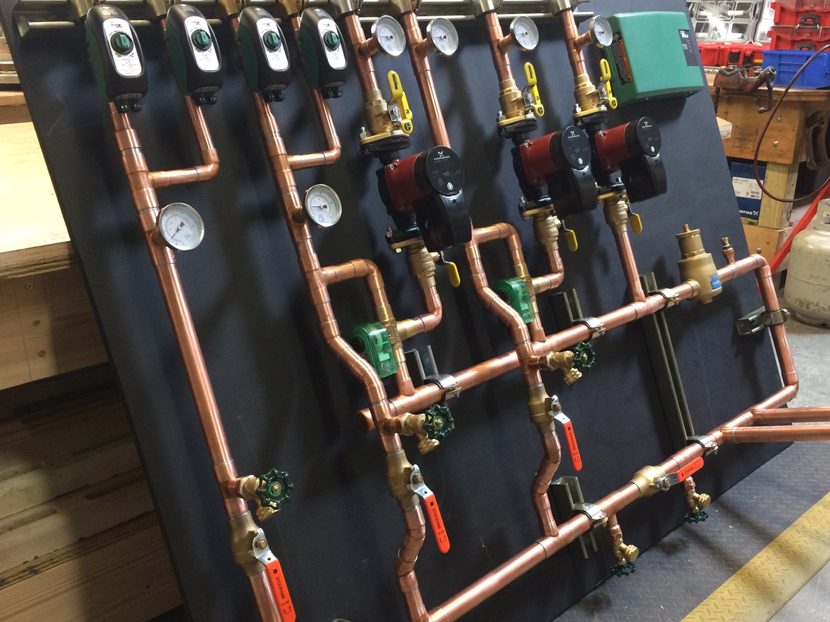Boiler Room Prefabrication
You can save money and effort — and have fun doing it — by prefabbing your own hydronic panels.

The way I see it, we have three ways to put together a boiler room. We can piece it together on site, fitting by fitting, following a piping schematic. We can buy a prefab panel from a manufacturer. Or, we can build our own prefab panel suited specifically for the job it’s intended for. I’ve done it every way, many times. For me, prefabbing my own panels is the best way and one of the things I enjoyed most as a contractor. For the past 15 years, it’s been a natural choice for me.
It’s not like having to choose between Willie, Mickey and the Duke: three guys who played the same position, in the same sport, in the same city, at the same time, and all three enshrined in the Baseball Hall of Fame. Willie Mays, Mickey Mantle and Duke Snider all played center field in New York City in the 1950s. Willie roamed the Polo Grounds for the Giants in Upper Manhattan, Duke manned Ebbets Field in Brooklyn for the real Dodgers and Mickey succeeded Joe DiMaggio at Yankee Stadium in the Bronx.
How do you choose between those three guys? Who’s the best? The New York fan base had it a lot tougher than us boiler guys do.
For me, at least, the decision to prefab my own is a no-brainer. The concept has been around for a long time. Wirsbo (now, Uponor) and Danfoss were making panels decades ago. I started making my own in the early 2000s. Some contractors, like me, swear by it while others say they don’t have time for it; the latter point I hope to convince you is just flat-out wrong.
I’m going to show you why it’s the best way, how I did it, why I loved doing it and why I miss it.
The job is sold, the design is complete and you’ve got your down payment. Now is the time when the customer’s expectations are at their highest so far in the process. They’ve picked your company over two other reputable competitors. They’ve trusted you with their money to get things moving in the right direction for their hydronic system that has been problematic for years. It’s time for you to deliver now on your promises and guarantees. No going back now. Go big or go home.
Measuring the job
I start with my initial piping schematic. This way, I have an idea of how much wall space I’m going to need. There’s going to be times where it just doesn’t seem possible that a prefab panel will work or fit. I’m urging you to be creative and think outside the box before giving up. Take the mess in Figure 1, for example.
I have a limited amount of space to work with. Just to the right of the boiler, there’s the return drop for the AC air handler. On the left, I’m being jammed by the electrical box. The back wall isn’t doing me any favors either. There’s gas pipe, four sticks of 1/2-inch EMT and a backflow preventer for the swimming pool.
I’m committed to making this new system look as good as it will work. After giving this a lot of thought and review, I’m ready to share my plan with the owners. The extra hour of imaginative thinking is going to save me 10 times that amount of time in execution. It’s similar to the “measure twice, cut once” theory. Here’s my plan:
• I have 64 inches of the back wall to work with and an almost unlimited amount of height if I remove the aforementioned gas, electric and backflow preventer.
• I’ll swing the new boiler 90 degrees to the left, making the entire back wall a blank canvas. The right-hand side of the Lochinvar Knight will not extend any further into the room than the existing Dunkirk; a win-win.
• Every hydronic pipe and component in the picture will be removed and replaced by someone not named Moe, Larry or Curly.
• The existing boiler is serving six bathrooms with radiant floors, two detached garages and one relatively small snow-melt zone. Each bathroom is on its own zone, and I plan to change it to a single zone controlled by the master bathroom thermostat. This will prevent the inevitable short-cycling that’s been occurring.
• I’m also going to move all the snowmelt components to an adjacent unused closet; glycol throughout.
It doesn’t happen all the time, but the owners were very forward-thinking people and gave me the go-ahead on everything I suggested.
Back at the shop
I tweak my drawing to meet the challenges and arrangement of the room. On my largest bench, I roll out some blue masking exactly 64 inches apart. Within that space, I’m going to build a new boiler room.
In the shop, I have all the fittings, pipe, pumps, zone valves, isolation valves, relays, lengths of strut, strut clamps, plywood, paint, tools, ball valves, torches, solder, press tools, threading tools and electrical supplies that I could possibly need. All of them neatly arranged and organized near the benches for the sole purpose of efficient prefabrication.
I can play whatever music I want and as loud as I want. I don’t have to take my Red Wings on and off all day long, running back and forth to the truck for this, that and the other thing I forgot the last trip to the truck. I don’t have to ask to use the washroom throughout the day. There’s not a tarp laid out anywhere. Why would there be? It’s a shop floor. Oh, and maybe I’ll order a sausage, pepper and onion pizza for lunch. You see where I’m going with this? For boiler guys and gals, this is a small piece of heaven.
I am truly in my element and once I get rolling, I’m not leaving until it’s done. That’s how much I enjoy this stuff. If it weren’t my job, it would’ve been my hobby. Seven to eight hours later and it’s going to look like Figure 2.
Do you see how I’ve used the strut and clamps to lock in my pipe by attaching it to the bench? I don’t want the new black panel getting all messed up, so I wait until the piping is complete before transferring over to the actual panel. It’s the little things that add up to big differences.
Don’t forget the electric and control wiring. A lot of it can be done in the shop, too. If you’re not prewiring after you prepipe, you’re leaving money on the table. Don’t leave money on the table.
Once I’m done piping, I slide my work onto a precut, prepainted piece of 3/4-inch plywood (Figure 3). From there, I wire the circulators, relays, zone valves, mixing valves and transformers as far as I can. I’ll even add a 1900 box and service switch. The placement of the boiler supply and return on the bottom of right of the picture was no accident. You want to get everything lined up as best you can so that when you get on site, everything falls into place.
I’ve gone as big as 4-foot by 8-foot panels without having a problem getting them on my Chevy Express 250 cargo van.
And back to the job
This is the time and place where you can expect the word “Wow!” When you take your clients’ boiler room from Figure 1 to Figure 4, they’re going to be impressed. I guarantee it.
And you’ve saved a ton of money and effort — and had fun doing it. There were 15 exterior concrete stairs leading to the basement of this home. But the boiler room was on the other side of the basement and that path was covered with expensive carpet. I saved myself so much time and energy by thinking this one all the way through, coming up with a detailed plan and then executing it.
By the way, I think Willie Mays was the greatest baseball player who ever lived. I think Mickey Mantle could have been if it weren’t for injuries and some other things. Duke Snider played for my favorite baseball team not from Chicago. Honestly, none of these guys would be a choice.
Choose wisely when piping your boiler rooms.





